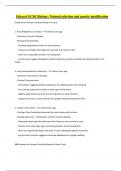Exam (elaborations)
Edexcel GCSE Biology: Natural selection and genetic modification
- Course
- Institution
Edexcel GCSE Biology: Natural selection and genetic modification Evidence for Human Evolution Based on Fossils 1. Ardi (Ardipithecus ramidus) - 4.4 million years ago - Discovery: Found in Ethiopia. - Physical Characteristics: - Climbing adaptations evident in foot structure. - Long arms and leg...
[Show more]



